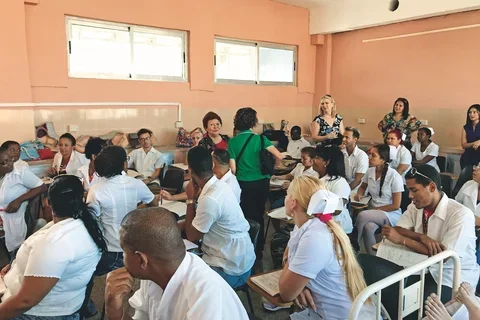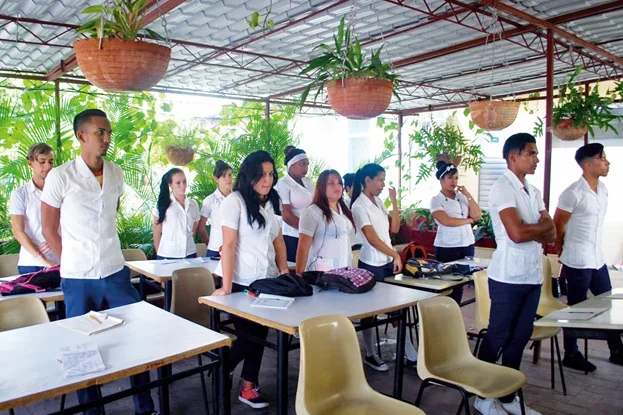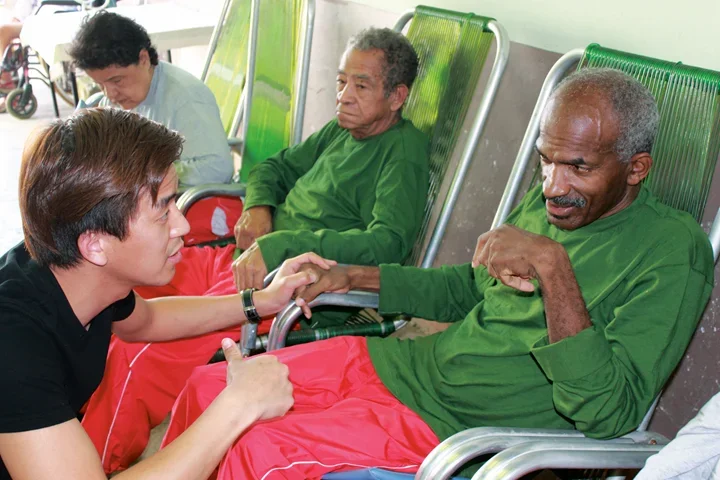Beyond Borders: Cuba Embraces Visiting Nursing Students

2,000 miles away in Havana, Cuba, our UCLA nursing students are plunged in a disparate landscape of vibrantly colored buildings, Caribbean music, vintage cars reminiscent of the 1960s “low-riders”, and an exceptional health care system.
Dr. Maria Elena Ruiz, adjunct associate professor, first traveled to Cuba with a prestigious group of delegates selected by the American Public Health Association in 2012. Impressed by Cuba’s health care system, Ruiz developed an academic travel program to Cuba in 2013.
One of the main things this program teaches students, Ruiz said, is there’s a world outside surviving and excelling without the advanced technology students are accustomed to.
What the students learn throughout their week-long visit is that despite being a developing socialist country, Cuba boasts a nearly identical life expectancy to the United States, almost 100% immunization rate, newly developed medications, some of the world’s lowest percentage of vaccine-preventable disease, and a highly accessible primary care system in which teams of doctors and nurses knock on patient’s doors for regular check-ups. Although they spend nearly 15 times less than the United States on health care per capita, Cuba’s health care system was lauded as internationally exemplary by Margaret Chan, former general director of the World Health Organization.
“We live in a high income, high technology country, and yet we experience health care gaps and increasing health disparities,” Ruiz said. “I want students to appreciate how health care is provided in other countries, and I hope when they work in underserved areas, they don’t feel that they have to rely on technology, as their skills, communication styles, empathy, and ability to assess will guide their diagnosis and ultimately their relationships with patients and communities.”

POLYCLINIC
During a visit to a consultorio (neighborhood clinic) and the polyclinic, the comprehensive community health center for each neighborhood, students learn about the Cuban health model. Doctors and nurses are required to reside in the community that they work in and are responsible for the families within the geographic location. As a result, health care providers develop close relationships with the families in their care.
Maria Del Ruth, MSN ‘15, who visited in 2014, said patients in Cuba are called by their names, not just referred to as a number. “Nurses and family doctors know the people from infancy on,” she added.
Primary care doctors can assess not only their client’s physical health risks but also psychological health needs. “I think by knowing our patients from a comprehensive standpoint, including psychosocially, we can educate and normalize the use of mental health services that are beneficial to the patient,” APRN students Lindsey Zamarripa and Ikwinder Bhurjee, wrote in their 2017 travel blog.
Despite a severe lack of equipment and technology (oxygen tanks, beds, and IV equipment from the 1970s being used in the clinics), Cuba’s system compensates in its training of health care staff and its focus on prevention and health promotion over treatment.
“They make do with so little, but they are able to accomplish so much,” added Jacqueline Marroquin, MSN ‘15, now a Family Nurse Practitioner.

MATERNITY HOUSE
Maternity homes in Cuba provide comprehensive care for women with “high risk” pregnancies, which includes multiple births, low weight gain and young maternal age. Cuba’s excellent, free maternal care is cited as one of the factors that result in Cuba’s low infant and maternal mortality rate.
The women with high risk pregnancies live at a maternity home until delivery. They are provided balanced diets, provided education and guidance, and their families are permitted to visit any time. However, the women are not allowed to leave the facility, which some students found a little disconcerting.
One APRN student said she found it upsetting that the women with high risk pregnancies had to leave their children and homes. “This was so different from what is practiced in the U.S.” But, another student felt that the health benefits of maternity homes outweighed the women’s lack of freedom and their risk of losing a baby.
“Although I thought it was sad that they were in a ward for anything from 1-5 months, away from their homes, lives and independence, the low infant mortality rates made me feel it was justifiable,” she said.
LA CASA DE ABUELAS,CARING FOR CUBA’S SENIORS
Similar to the rest of the world, Cuba faces an aging population. In a country where 9.51 babies are born per 1,000 Cubans, governmental care for the elderly becomes a pressing issue. To understand Cuba’s approach to aging, students visited senior homes, or Casa de Abuelos.
“The medical director explained that these are lovingly referred to as casas for abuelitos (grandparents), as the medical and nursing providers care for the residents as a member of the family and not as a patient,” said Ruiz. Cuba sponsors these senior day care centers, and if any fees are charged, it is very low.
Lily Hakhpandyan and Izabela Harutyunyan, APRN students (class of 2018), said the Casa de Abuelos No. 2 they visited in 2017, was joyful and pleasant.
“We met Soledad, one of the thinnest, frailest looking women. Much to our surprise, Soledad wanted to teach us how to dance! We gathered around the porch and shimmied our hips to ‘Havana’. We ended the visit by teaching the seniors the UCLA 8-clap!” they said.
ELAM EDUCATION
Students also visited Cuba’s renowned International medical school. Cuba was dubbed by former U.N. Secretary General Ban Ki-moon as a country with “the world’s most advanced medical school.” In particular, he praised ELAM, Escuela Latinoamericana de Medicina, as “genius for world health contributions” and has educated doctors who are often “the first to arrive and the last to leave” in disasters and crises. Every year, our students meet with students in ELAM — several of these students are from the U.S.
UCLA students learned that ELAM provides full scholarships to students and provides free health care, dental care, shelter, food, and housing for all the students. But there is one caveat: all classes are in Spanish, and students selected for the program are expected to return to their home country and provide care in underserved areas.
On average, nurses and doctors make only $25-67 a month. However, their education and housing are free or subsidized, and government funded education alleviates the burden of student loans.
“In the U.S., you wouldn’t have a lot of people pursuing these professions for that kind of pay,” said John Scholtz, MECN ‘15, “But in Cuba, you have a lot of people interested in being doctors or nurses because they want to make a difference in their community.”
NURSING EDUCATION
Another highlight is the relationships that have been made with nursing schools in Cuba. As the program has expanded, so have the visits and exchanges with key medical, nursing and public health leaders. Last year they met with the Chief Nursing Officer and President of the Cuban Nursing Association. At a premier university, the group was welcomed by the Dean of Nursing and visited a classroom and lab. APRN students Michelle Neverida and Hsun-yu Vuong noted the difference in materials and technology available, and mentioned that “our mannequins breathe, have heart sounds and talk to us, but when technology breaks down, there might be lessons here that we can learn.”
Fast forward to 2018, UCLA is now anticipating the 6th annual trip to Cuba and it improves every year. Almost 100 nursing students have now participated in the annual Cuba program.
Key speakers from relationships developed over the years are always excited to speak with students, Ruiz said. “I’d even say we have ‘special treatment’ in terms of the quality of speakers.”
The School’s Cuba trip also set many precedents.
“We are the first all nurse student group to take such a trip to Cuba…we were one of the first to land in Cuba after the Obama administration re-established relationships in 2014. That was an exciting moment!” Ruiz said. “Everywhere we went we were greeted with hugs, kisses and tears of joy. The students and faculty are first class global health ambassadors, and they are leaving lasting impressions on the Cuban colleagues. We’re increasing opportunities for our future nurse leaders.”
— by Wendy Li, UCLA Class of 2021